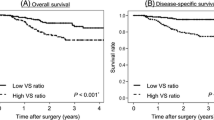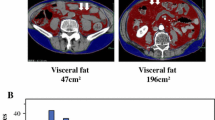Abstract
Background
While an association between esophago-gastric junctional adenocarcinomas (EGJACs) and obesity, especially visceral obesity, has been suggested in Western countries, the association remains unclear in Asia, including Japan. In this population-based case–control study, we investigated the association between EGJACs and obesity.
Methods
To perform near-population-based data collection for all early-stage EGJACs occurring in Akita Prefecture from 2014 to 2019, clinical data, including endoscopic and computed tomography (CT) findings, were collected from 11 cancer treatment base hospitals in the area. Age- and gender-matched controls were extracted at a case-to-control ratio of 1:2 from healthy subjects who received health checkups in the same area. The visceral fat area (VFA) was calculated using CT images. Logistic regression analyses were performed to investigate the associations between EGJACs and obesity-related parameters.
Results
In total, 74 EGJAC cases (62 males, median age of 70 years old) and 148 controls were extracted. Multivariable analyses showed a significantly negative association between the BMI and EGJACs and a significantly positive association between the VFA and EGJACs with odds ratios (ORs) (95% confidence intervals [CIs]) of 0.65 (0.53–0.80) and 1.01 (1.01–1.02), respectively. These findings were confirmed in another dataset (40 EGJACs and 80 controls). In addition, as a categorical variable, VFA ≥ 100 cm2 showed a significantly positive association with EGJACs (OR [95% CI] 1.96 [1.02–3.76]).
Conclusions
We found paradoxical associations between EGJACs and obesity-related parameters (BMI vs. VFA) in a Japanese population, suggesting a potentially pivotal role of the VFA rather than the BMI as a risk factor for EGJACs.

Similar content being viewed by others
References
Melina A, Isabelle S, Jacques F, et al. Global incidence of oesophageal cancer by histological subtype in 2012. Gut. 2015;64:381–7.
Thrift AP, Whiteman DC. The incidence of esophageal adenocarcinoma continues to rise: analysis of period and birth cohort effects on recent trends. Ann Oncol. 2012;23:3155–62.
Kubo A, Corley DA. Body mass index and adenocarcinomas of the esophagus or gastric cardia: a systematic review and meta-analysis. Cancer Epidemiol Biomark Prev. 2006;15:872–8.
Kvist H, Chowdhury B, Sjostrom L, et al. Adipose tissue colume determination in males by computed tomography and 40 K. Int J Obes. 1988;12:239–66.
Bulcão C, Ferreira SR, Giuffrida FM, et al. The new adipose tissue and adipocytokines. Curr Diabetes Rev. 2006;2:19–28.
El-Serag HB, Kvapil P, Hacken-Bitar J, et al. Abdominal obesity and the risk of Barrett’s esophagus. Am J Gastroenterol. 2005;100:2151–6.
El-Serag HB, Hashmi A, Garcia J, et al. Visceral abdominal obesity measured by CT scan is associated with an increased risk of Barrett’s oesophagus: a case–control study. Gut. 2014;63:220–9.
Massl R, van Blankenstein M, Hermans JJ, et al. Visceral adipose tissue: the link with esophageal adenocarcinoma. Scand J Gastroenterol. 2014;49:449–57.
Beddy P, Howard J, McMahon C, et al. Association of visceral adiposity with oesophageal and junctional adenocarcinomas. Br J Surg. 2010;97:1028–34.
Koizumi S, Motoyama S, Iijima K. Is the incidence of esophageal adenocarcinoma increasing in Japan? Trends from the data of a hospital-based registration system in Akita Prefecture. Japan J Gastroenterol. 2018;53:827–33.
Nishi T, Makuuchi H, Ozawa S, et al. The present status and future of Barrett’s esophageal adenocarcinoma in Japan. Digestion. 2019;99:185–90.
Matsuno K, Ishihara R, Ohmori M, et al. Time trends in the incidence of esophageal adenocarcinoma, gastric adenocarcinoma, and superficial esophagogastric junction adenocarcinoma. J Gastroenterol. 2019;54:784–91.
Matsueda K, Manabe N, Toshikuni N, et al. Clinical characteristics and associated factors of Japanese patients with adenocarcinoma of the esophagogastric junction: a multicenter clinicoepidemiological study. Dis Esophagus. 2017;30:1–6.
Zhang J, Su XQ, Wu XJ, et al. Effect of body mass index on adenocarcinoma of gastric cardia. World J Gastroenterol. 2003;9:2658–61.
Usui G, Shinozaki T, Jinno T, et al. Association between visceral abdominal obesity and long-segment Barrett’s esophagus in a Japanese population. J Gastroenterol. 2020;55:189–97.
Koizumi S, Motoyama S, Watanabe N, et al. Chronological changes in the gastric cancer subsite in Akita, Japan: the trends from the data of a hospital-based registration system. Tohoku J Exp Med. 2018;246:131–40.
Siewert JR, Stein HJ. Classification of carcinoma of the oeso-phagogastric junction. Br J Surg. 1998;85:1457–9.
Takubo K, Vieth M, Aida J, et al. Histopathological diagnosis of adenocarcinoma in Barrett’s esophagus. Dig Endosc. 2014;26:322–30.
Japan Esophageal Society. Japanese classification of esophageal cancer, 11th edition: part I. Esophagus. 2017;14:1–36.
Tokunaga K, Matsuzawa Y, Ishikawa K, et al. A novel technique for the determination of body fat by computed tomography. Int J Obes. 1983;7:437–45.
Fukuda S, Watanabe K, Yoshida T, et al. Low risk of esophageal adenocarcinoma among patients with ultrashort-segment Barrett’s esophagus in Japan. Dig Endosc. 2021. https://doi.org/10.1111/den.14118.
Examination Committee of Criteria for ‘Obesity Disease’ in Japan; Japan Society for the Study of Obesity New criteria for ‘obesity disease’ in Japan. Cir J 2002;66:987–92.
Hiuge-Shimizu A, Kishida K, Funahashi T, et al. Absolute value of visceral fat area measured on computed tomography scans and obesity-related cardiovascular risk factors in large-scale Japanese general population (the VACATION-J study). Ann Med. 2012;44:82–92.
Kanda Y. Investigation of the freely available easy-to-use software “EZR” for medical statistics. Bone Marrow Transplant. 2013;48:452–8.
Lagergren J, Bergstrom R, Nyren O. Association between body mass and adenocarcinoma of the esophagus and gastric cardia. Ann Intern Med. 1999;130:883–90.
Anderson LA, Watson RG, Murphy SJ, et al. Risk factors for Barrett’s oesophagus and oesophageal adenocarcinoma: results from the FINBAR study. World J Gastroenterol. 2007;13:1585–94.
Dalamaga M, Diakopoulos KN, Mantzoros CS. The role of adiponectin in cancer: a review of current evidence. Endocr Rev. 2012;33:547–94.
Vucenik I, Stains JP. Obesity and cancer risk: evidence, mechanisms, and recommendations. Ann N Y Acid Sci. 2012;1271:37–43.
Nam SY, Choi IJ, Ryu KH, et al. Abdominal visceral adipose tissue volume is associated with increased risk of erosive esophagitis in men and women. Gastroenterology. 2010;139:1902–11.
Pandolfino JE, El-Serag HB, Zhang Q, et al. Obesity: a challenge to esophagogastric junction integrity. Gastroenterology. 2006;130:639–49.
Fontana L, Eagon JC, Trujillo ME, et al. Visceral fat adipokine secretion is associated with systemic inflammation in obese humans. Diabetes. 2007;56:1010–3.
Kim YM, Kim JH, Baik SJ, et al. Sarcopenia and sarcopenic obesity as novel risk factors for gastric carcinogenesis: a health checkup cohort study. Front Oncol. 2019;9:1249.
Wannamethee SG, Atkins JL. Muscle loss and obesity: the health implications of sarcopenia and sarcopenic obesity. Proc Nutr Soc. 2015;74:405–12.
Ciudin A, Simo-Servat A, Palmas F, et al. Sarcopenic obesity: a new challenge in the clinical practice. Endocrinol Diabetes Nutr (Engl Ed). 2020;67:672–81.
The National Health and Nutrition Survey in Japan, 2016. The Ministry of Health, Labor and Welfare. 2016. https://www.nibiohn.go.jp/eiken/kenkounippon21/en/eiyouchousa/.
Hansen S, Vollset SE, Derakhshan MH, et al. Two distinct aetiologies of cardia cancer; evidence from premorbid serological markers of gastric atrophy and Helicobacter pylori status. Gut. 2007;56:918–25.
Horii T, Koike T, Abe Y, et al. Two distinct types of cancer of different origin may be mixed in gastroesophageal junction adenocarcinomas in Japan: evidence from direct evaluation of gastric acid secretion. Scand J Gastroenterol. 2011;46:710–9.
Author information
Authors and Affiliations
Corresponding author
Ethics declarations
Ethical statement
This study was approved by the Ethics Committee of Akita University Graduate School of Medicine (2294) and other cooperating institutions.
Conflict of interest
The authors declare that they have no conflict of interest associated with this manuscript.
Additional information
Publisher's Note
Springer Nature remains neutral with regard to jurisdictional claims in published maps and institutional affiliations.
Supplementary Information
Below is the link to the electronic supplementary material.
Rights and permissions
About this article
Cite this article
Watanabe, K., Koizumi, S., Shirane, K. et al. Visceral obesity is associated with an increased risk of developing esophago-gastric junctional adenocarcinoma in Japan: a population-based case–control study in Akita Prefecture. Esophagus 19, 477–485 (2022). https://doi.org/10.1007/s10388-021-00906-1
Received:
Accepted:
Published:
Issue Date:
DOI: https://doi.org/10.1007/s10388-021-00906-1




